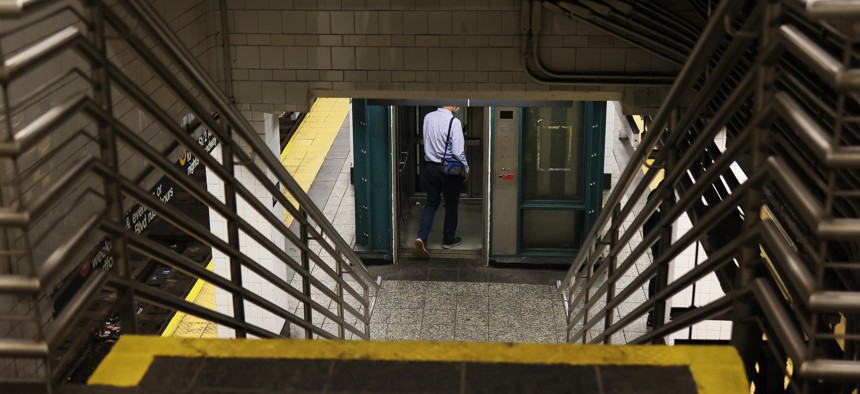Opinion
Opinion: The MTA is committed to accessibility
Two years after a landmark ADA settlement, the MTA has made real progress on making subway stations accessible to all.

A person enters the elevator in the Atlantic Avenue-Barclays Center subway station on June 23, 2022. Michael M. Santiago/Getty Images
Transit accessibility is not an abstract concept for me. As a wheelchair user, I brush up against the limitations of the subway system every day. I’m on the MTA website and app daily to check on elevator availability and changes in service that might cause trains to bypass accessible stations – and I use that lived experience to inform my work as MTA’s first-ever chief accessibility officer. From my vantage point, the agency has never been more committed to accessibility than it is now.
Two years ago, we entered a historic legal settlement that affirms the MTA’s commitment to New Yorkers with disabilities – and everyone else who might have limited mobility and/or access needs – with a clear and defined path toward universal subway access by the year 2055.
It is an ambitious goal, but this is a new MTA. We deliver ADA projects five times faster than prior administrations. Where we used to award two or three contracts a year for accessibility projects, the annual average is now 13. As a result, 153 of 493 subway and Staten Island Railway stations are currently accessible, up from 123 in 2019, with another 38 in construction right now. We hope to include even more in the next MTA Capital Program, which will be announced later this month.
But we know it is not enough just to install new elevators; they need to work. On a given day, roughly 97% of MTA elevators are in service, and the worst-performing ones tend to be operated by third party developers. To rectify that, in 2023 we convened a multi-departmental working group and started imposing tougher penalties on companies when their elevators don’t meet MTA standards. Since then, elevator availability has shot up from 80% to almost 96%. That’s great progress, and we want to do even better.
In the meantime, New Yorkers can join me riding the subway and MTA’s already fully accessible bus and paratransit systems. The latter is in the middle of a renaissance, with unprecedented ridership and customer satisfaction. A record high 79% of Access-A-Ride users in January 2024 said they were satisfied with service as ridership grew 12.4% compared to the year before, with most days above pre-COVID levels.
The agency has also abandoned the industry standard 30-minute on-time window in favor of a more customer friendly 20 minutes. Even with that change, paratransit on-time performance has consistently exceeded 90%.
Additionally, booking trips is faster and easier thanks to new upgrades to the mobile booking process and the time required to make a reservation over the phone has dropped 22%, from more than six minutes to under five. Most importantly, we’ve expanded the e-hail pilot program, which allows participants the opportunity to book trips in real-time through five taxi or for-hire vehicle services. More flexibility for more users.
Bottom line: transit accessibility is a major priority for the MTA. Expanding it is the right thing to do and will have big benefits for all of us.
New York is home to more than one million people with disabilities (myself included) and more than 1.5 million residents over the age of 65, not to mention roughly 250,000 children under two whose families use strollers to get around. None of us should be left stranded by transit.
As long as I work at the MTA, I will be a champion for everyone who has to change plans around diversions through accessible stations. Together we can build a more inclusive system, where text alerts and elevator outage trackers won’t be so necessary. Accessibility will simply be a given.
Quemuel Arroyo is the MTA’s chief accessibility officer.
NEXT STORY: Editor’s note: Jessica Ramos makes a timely announcement

